Brand Management Report: Strategies, Equity, Portfolio, and Value
VerifiedAdded on 2020/06/06
|16
|5125
|493
Report
AI Summary
This report delves into the critical aspects of brand management, providing a comprehensive overview of branding's significance in business practices. It examines the key components of a successful brand strategy, emphasizing the importance of building and managing brand equity. The report further explores strategies for effective portfolio management and the establishment of a brand hierarchy. Additionally, it analyzes brand management practices at both global and local levels, assessing techniques used to measure brand value. The report covers crucial topics such as managing brand over time, challenges faced, managing brand equity, and the significance of customer perspectives and brand architecture models in portfolio management. The report uses examples of well-known brands like Nike and Adidas to illustrate the concepts. Finally, the report emphasizes the strategic alignment of brand portfolio management with overall business strategies to achieve desired market growth and position.

BRAND MANAGEMENT
Paraphrase This Document
Need a fresh take? Get an instant paraphrase of this document with our AI Paraphraser
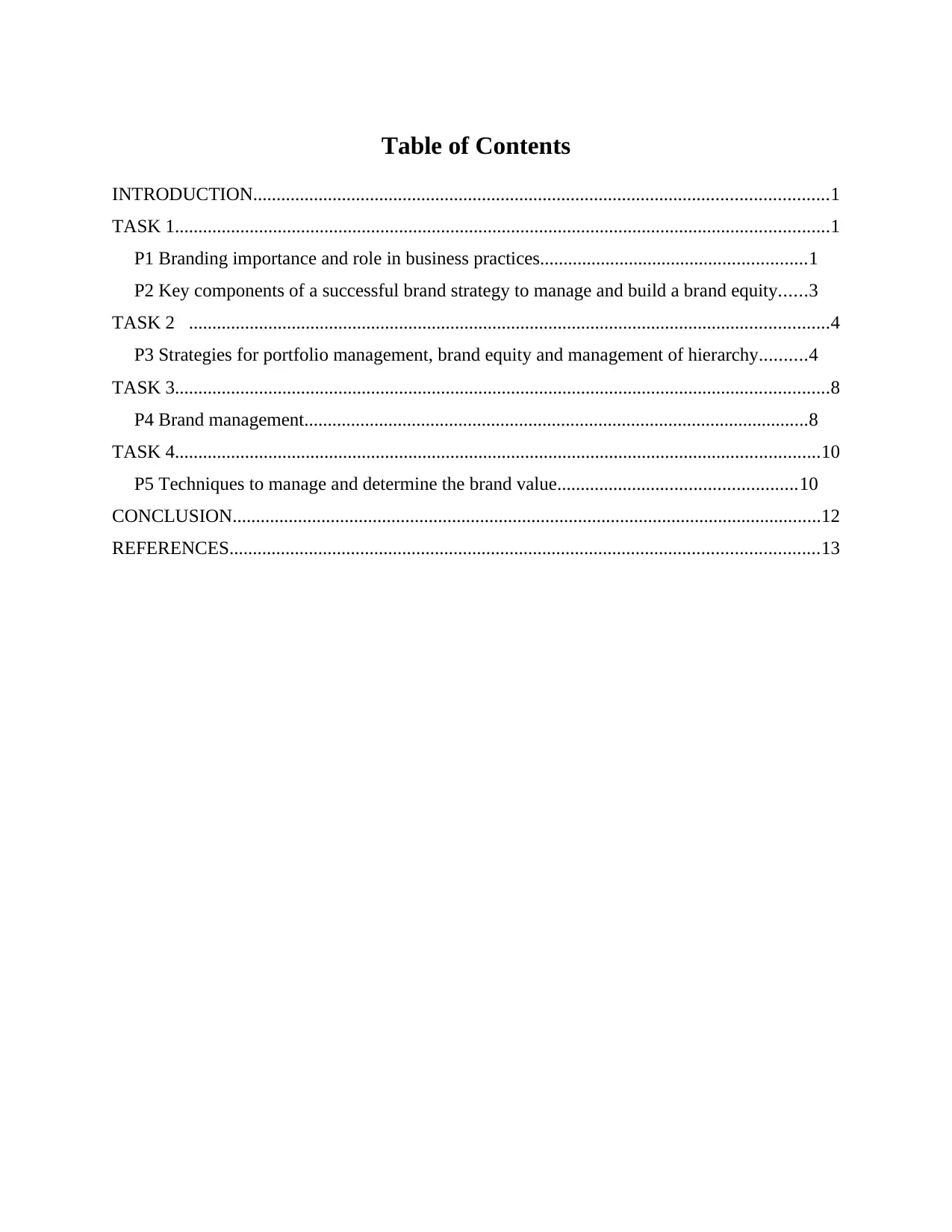
Table of Contents
INTRODUCTION...........................................................................................................................1
TASK 1............................................................................................................................................1
P1 Branding importance and role in business practices.........................................................1
P2 Key components of a successful brand strategy to manage and build a brand equity......3
TASK 2 .........................................................................................................................................4
P3 Strategies for portfolio management, brand equity and management of hierarchy..........4
TASK 3............................................................................................................................................8
P4 Brand management............................................................................................................8
TASK 4..........................................................................................................................................10
P5 Techniques to manage and determine the brand value...................................................10
CONCLUSION..............................................................................................................................12
REFERENCES..............................................................................................................................13
INTRODUCTION...........................................................................................................................1
TASK 1............................................................................................................................................1
P1 Branding importance and role in business practices.........................................................1
P2 Key components of a successful brand strategy to manage and build a brand equity......3
TASK 2 .........................................................................................................................................4
P3 Strategies for portfolio management, brand equity and management of hierarchy..........4
TASK 3............................................................................................................................................8
P4 Brand management............................................................................................................8
TASK 4..........................................................................................................................................10
P5 Techniques to manage and determine the brand value...................................................10
CONCLUSION..............................................................................................................................12
REFERENCES..............................................................................................................................13
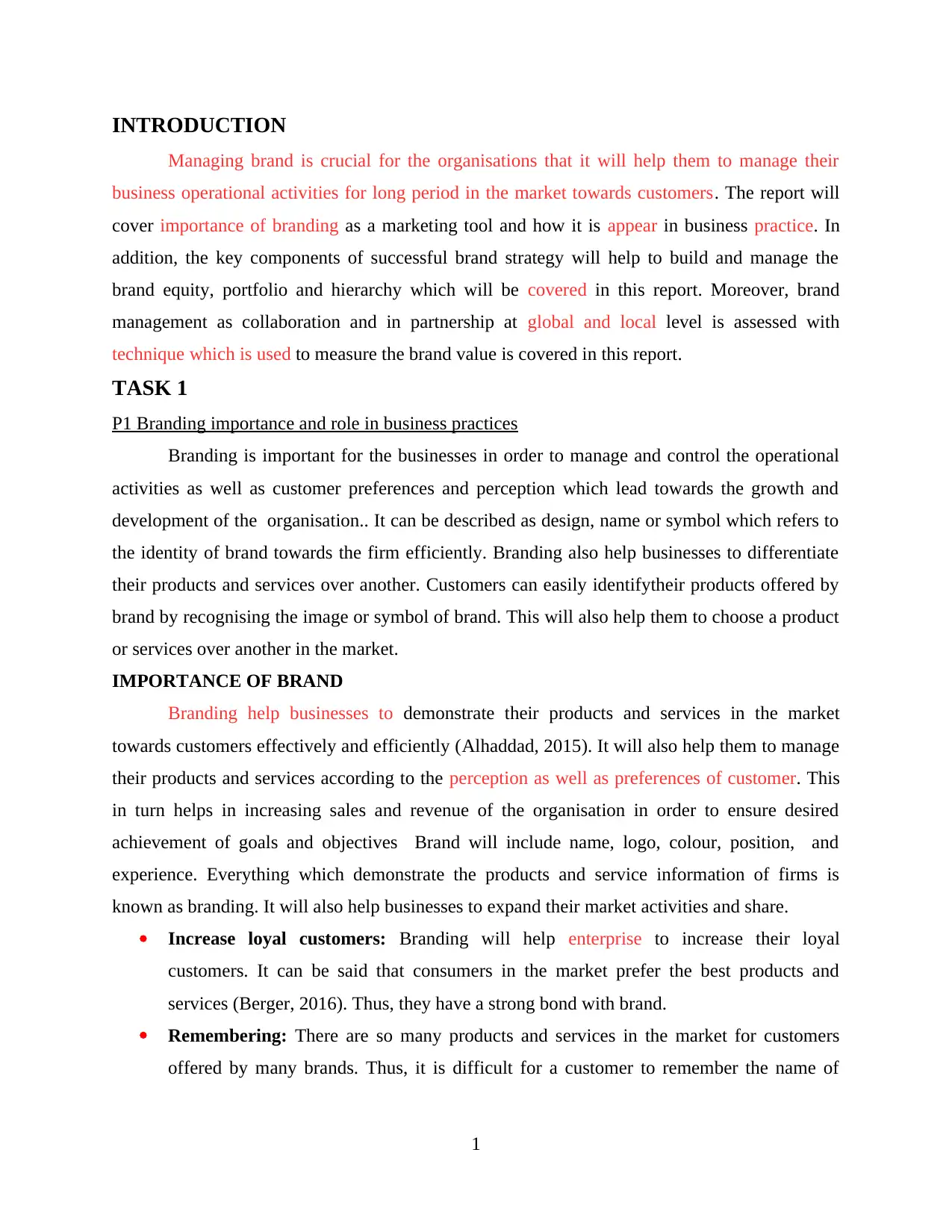
INTRODUCTION
Managing brand is crucial for the organisations that it will help them to manage their
business operational activities for long period in the market towards customers. The report will
cover importance of branding as a marketing tool and how it is appear in business practice. In
addition, the key components of successful brand strategy will help to build and manage the
brand equity, portfolio and hierarchy which will be covered in this report. Moreover, brand
management as collaboration and in partnership at global and local level is assessed with
technique which is used to measure the brand value is covered in this report.
TASK 1
P1 Branding importance and role in business practices
Branding is important for the businesses in order to manage and control the operational
activities as well as customer preferences and perception which lead towards the growth and
development of the organisation.. It can be described as design, name or symbol which refers to
the identity of brand towards the firm efficiently. Branding also help businesses to differentiate
their products and services over another. Customers can easily identifytheir products offered by
brand by recognising the image or symbol of brand. This will also help them to choose a product
or services over another in the market.
IMPORTANCE OF BRAND
Branding help businesses to demonstrate their products and services in the market
towards customers effectively and efficiently (Alhaddad, 2015). It will also help them to manage
their products and services according to the perception as well as preferences of customer. This
in turn helps in increasing sales and revenue of the organisation in order to ensure desired
achievement of goals and objectives Brand will include name, logo, colour, position, and
experience. Everything which demonstrate the products and service information of firms is
known as branding. It will also help businesses to expand their market activities and share.
Increase loyal customers: Branding will help enterprise to increase their loyal
customers. It can be said that consumers in the market prefer the best products and
services (Berger, 2016). Thus, they have a strong bond with brand.
Remembering: There are so many products and services in the market for customers
offered by many brands. Thus, it is difficult for a customer to remember the name of
1
Managing brand is crucial for the organisations that it will help them to manage their
business operational activities for long period in the market towards customers. The report will
cover importance of branding as a marketing tool and how it is appear in business practice. In
addition, the key components of successful brand strategy will help to build and manage the
brand equity, portfolio and hierarchy which will be covered in this report. Moreover, brand
management as collaboration and in partnership at global and local level is assessed with
technique which is used to measure the brand value is covered in this report.
TASK 1
P1 Branding importance and role in business practices
Branding is important for the businesses in order to manage and control the operational
activities as well as customer preferences and perception which lead towards the growth and
development of the organisation.. It can be described as design, name or symbol which refers to
the identity of brand towards the firm efficiently. Branding also help businesses to differentiate
their products and services over another. Customers can easily identifytheir products offered by
brand by recognising the image or symbol of brand. This will also help them to choose a product
or services over another in the market.
IMPORTANCE OF BRAND
Branding help businesses to demonstrate their products and services in the market
towards customers effectively and efficiently (Alhaddad, 2015). It will also help them to manage
their products and services according to the perception as well as preferences of customer. This
in turn helps in increasing sales and revenue of the organisation in order to ensure desired
achievement of goals and objectives Brand will include name, logo, colour, position, and
experience. Everything which demonstrate the products and service information of firms is
known as branding. It will also help businesses to expand their market activities and share.
Increase loyal customers: Branding will help enterprise to increase their loyal
customers. It can be said that consumers in the market prefer the best products and
services (Berger, 2016). Thus, they have a strong bond with brand.
Remembering: There are so many products and services in the market for customers
offered by many brands. Thus, it is difficult for a customer to remember the name of
1
⊘ This is a preview!⊘
Do you want full access?
Subscribe today to unlock all pages.

Trusted by 1+ million students worldwide
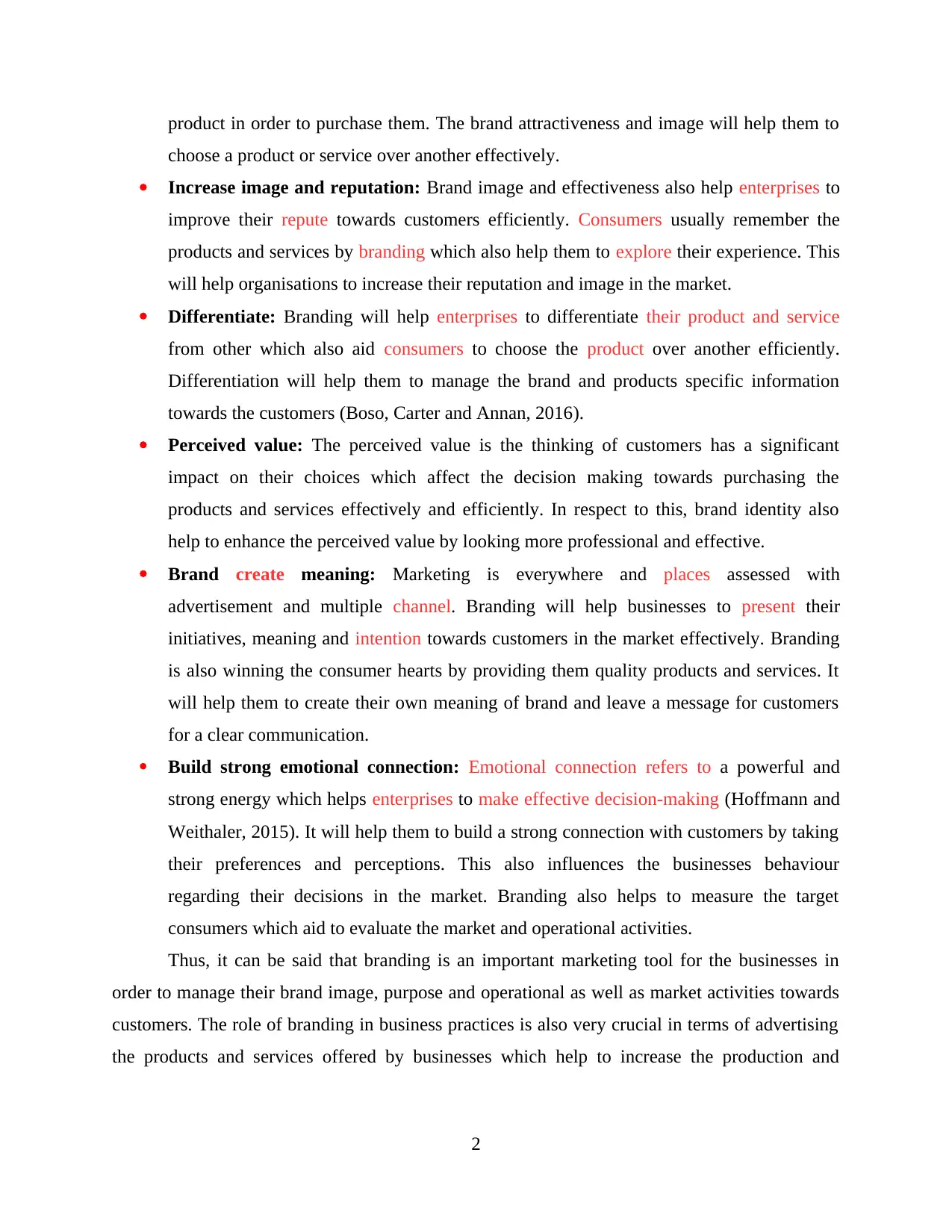
product in order to purchase them. The brand attractiveness and image will help them to
choose a product or service over another effectively.
Increase image and reputation: Brand image and effectiveness also help enterprises to
improve their repute towards customers efficiently. Consumers usually remember the
products and services by branding which also help them to explore their experience. This
will help organisations to increase their reputation and image in the market.
Differentiate: Branding will help enterprises to differentiate their product and service
from other which also aid consumers to choose the product over another efficiently.
Differentiation will help them to manage the brand and products specific information
towards the customers (Boso, Carter and Annan, 2016).
Perceived value: The perceived value is the thinking of customers has a significant
impact on their choices which affect the decision making towards purchasing the
products and services effectively and efficiently. In respect to this, brand identity also
help to enhance the perceived value by looking more professional and effective.
Brand create meaning: Marketing is everywhere and places assessed with
advertisement and multiple channel. Branding will help businesses to present their
initiatives, meaning and intention towards customers in the market effectively. Branding
is also winning the consumer hearts by providing them quality products and services. It
will help them to create their own meaning of brand and leave a message for customers
for a clear communication.
Build strong emotional connection: Emotional connection refers to a powerful and
strong energy which helps enterprises to make effective decision-making (Hoffmann and
Weithaler, 2015). It will help them to build a strong connection with customers by taking
their preferences and perceptions. This also influences the businesses behaviour
regarding their decisions in the market. Branding also helps to measure the target
consumers which aid to evaluate the market and operational activities.
Thus, it can be said that branding is an important marketing tool for the businesses in
order to manage their brand image, purpose and operational as well as market activities towards
customers. The role of branding in business practices is also very crucial in terms of advertising
the products and services offered by businesses which help to increase the production and
2
choose a product or service over another effectively.
Increase image and reputation: Brand image and effectiveness also help enterprises to
improve their repute towards customers efficiently. Consumers usually remember the
products and services by branding which also help them to explore their experience. This
will help organisations to increase their reputation and image in the market.
Differentiate: Branding will help enterprises to differentiate their product and service
from other which also aid consumers to choose the product over another efficiently.
Differentiation will help them to manage the brand and products specific information
towards the customers (Boso, Carter and Annan, 2016).
Perceived value: The perceived value is the thinking of customers has a significant
impact on their choices which affect the decision making towards purchasing the
products and services effectively and efficiently. In respect to this, brand identity also
help to enhance the perceived value by looking more professional and effective.
Brand create meaning: Marketing is everywhere and places assessed with
advertisement and multiple channel. Branding will help businesses to present their
initiatives, meaning and intention towards customers in the market effectively. Branding
is also winning the consumer hearts by providing them quality products and services. It
will help them to create their own meaning of brand and leave a message for customers
for a clear communication.
Build strong emotional connection: Emotional connection refers to a powerful and
strong energy which helps enterprises to make effective decision-making (Hoffmann and
Weithaler, 2015). It will help them to build a strong connection with customers by taking
their preferences and perceptions. This also influences the businesses behaviour
regarding their decisions in the market. Branding also helps to measure the target
consumers which aid to evaluate the market and operational activities.
Thus, it can be said that branding is an important marketing tool for the businesses in
order to manage their brand image, purpose and operational as well as market activities towards
customers. The role of branding in business practices is also very crucial in terms of advertising
the products and services offered by businesses which help to increase the production and
2
Paraphrase This Document
Need a fresh take? Get an instant paraphrase of this document with our AI Paraphraser
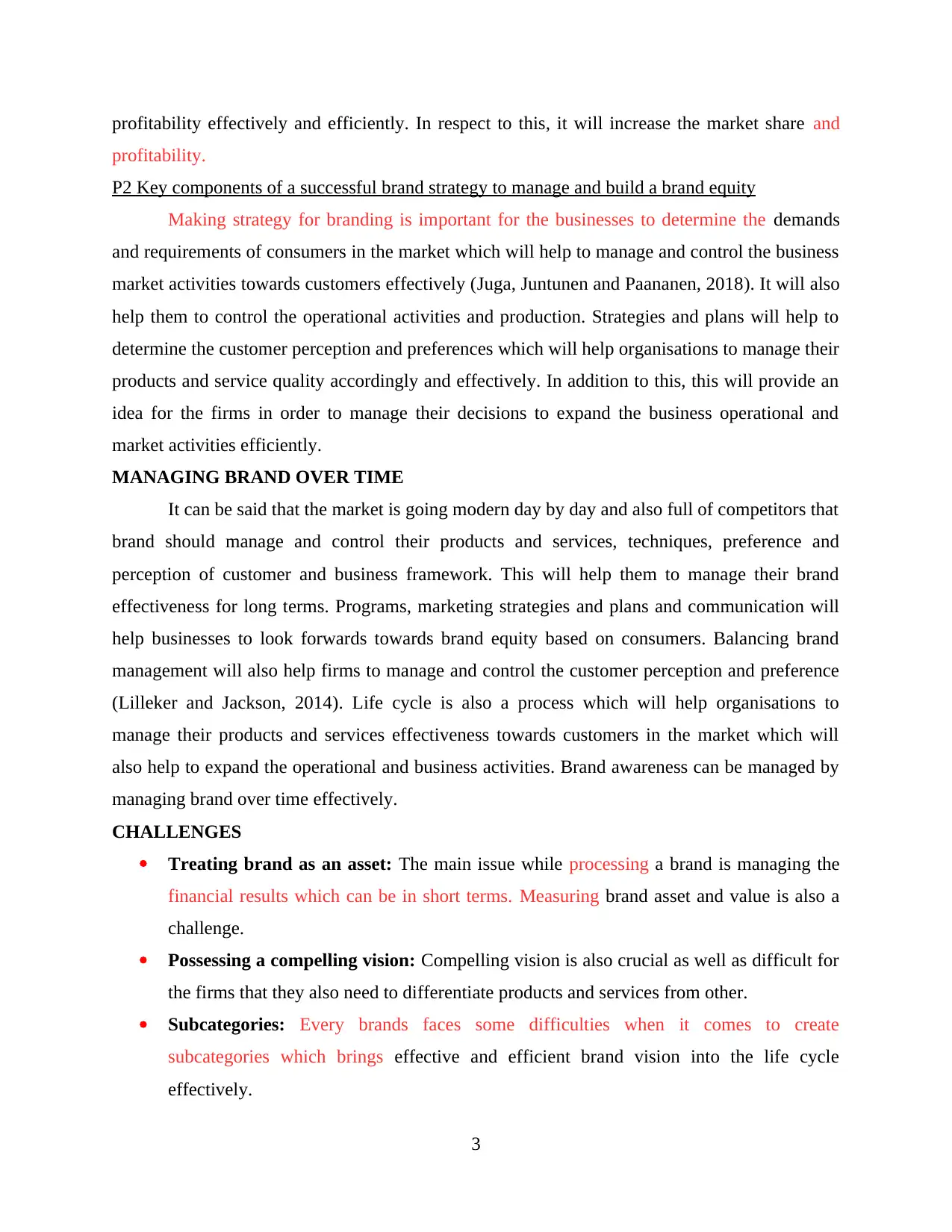
profitability effectively and efficiently. In respect to this, it will increase the market share and
profitability.
P2 Key components of a successful brand strategy to manage and build a brand equity
Making strategy for branding is important for the businesses to determine the demands
and requirements of consumers in the market which will help to manage and control the business
market activities towards customers effectively (Juga, Juntunen and Paananen, 2018). It will also
help them to control the operational activities and production. Strategies and plans will help to
determine the customer perception and preferences which will help organisations to manage their
products and service quality accordingly and effectively. In addition to this, this will provide an
idea for the firms in order to manage their decisions to expand the business operational and
market activities efficiently.
MANAGING BRAND OVER TIME
It can be said that the market is going modern day by day and also full of competitors that
brand should manage and control their products and services, techniques, preference and
perception of customer and business framework. This will help them to manage their brand
effectiveness for long terms. Programs, marketing strategies and plans and communication will
help businesses to look forwards towards brand equity based on consumers. Balancing brand
management will also help firms to manage and control the customer perception and preference
(Lilleker and Jackson, 2014). Life cycle is also a process which will help organisations to
manage their products and services effectiveness towards customers in the market which will
also help to expand the operational and business activities. Brand awareness can be managed by
managing brand over time effectively.
CHALLENGES
Treating brand as an asset: The main issue while processing a brand is managing the
financial results which can be in short terms. Measuring brand asset and value is also a
challenge.
Possessing a compelling vision: Compelling vision is also crucial as well as difficult for
the firms that they also need to differentiate products and services from other.
Subcategories: Every brands faces some difficulties when it comes to create
subcategories which brings effective and efficient brand vision into the life cycle
effectively.
3
profitability.
P2 Key components of a successful brand strategy to manage and build a brand equity
Making strategy for branding is important for the businesses to determine the demands
and requirements of consumers in the market which will help to manage and control the business
market activities towards customers effectively (Juga, Juntunen and Paananen, 2018). It will also
help them to control the operational activities and production. Strategies and plans will help to
determine the customer perception and preferences which will help organisations to manage their
products and service quality accordingly and effectively. In addition to this, this will provide an
idea for the firms in order to manage their decisions to expand the business operational and
market activities efficiently.
MANAGING BRAND OVER TIME
It can be said that the market is going modern day by day and also full of competitors that
brand should manage and control their products and services, techniques, preference and
perception of customer and business framework. This will help them to manage their brand
effectiveness for long terms. Programs, marketing strategies and plans and communication will
help businesses to look forwards towards brand equity based on consumers. Balancing brand
management will also help firms to manage and control the customer perception and preference
(Lilleker and Jackson, 2014). Life cycle is also a process which will help organisations to
manage their products and services effectiveness towards customers in the market which will
also help to expand the operational and business activities. Brand awareness can be managed by
managing brand over time effectively.
CHALLENGES
Treating brand as an asset: The main issue while processing a brand is managing the
financial results which can be in short terms. Measuring brand asset and value is also a
challenge.
Possessing a compelling vision: Compelling vision is also crucial as well as difficult for
the firms that they also need to differentiate products and services from other.
Subcategories: Every brands faces some difficulties when it comes to create
subcategories which brings effective and efficient brand vision into the life cycle
effectively.
3
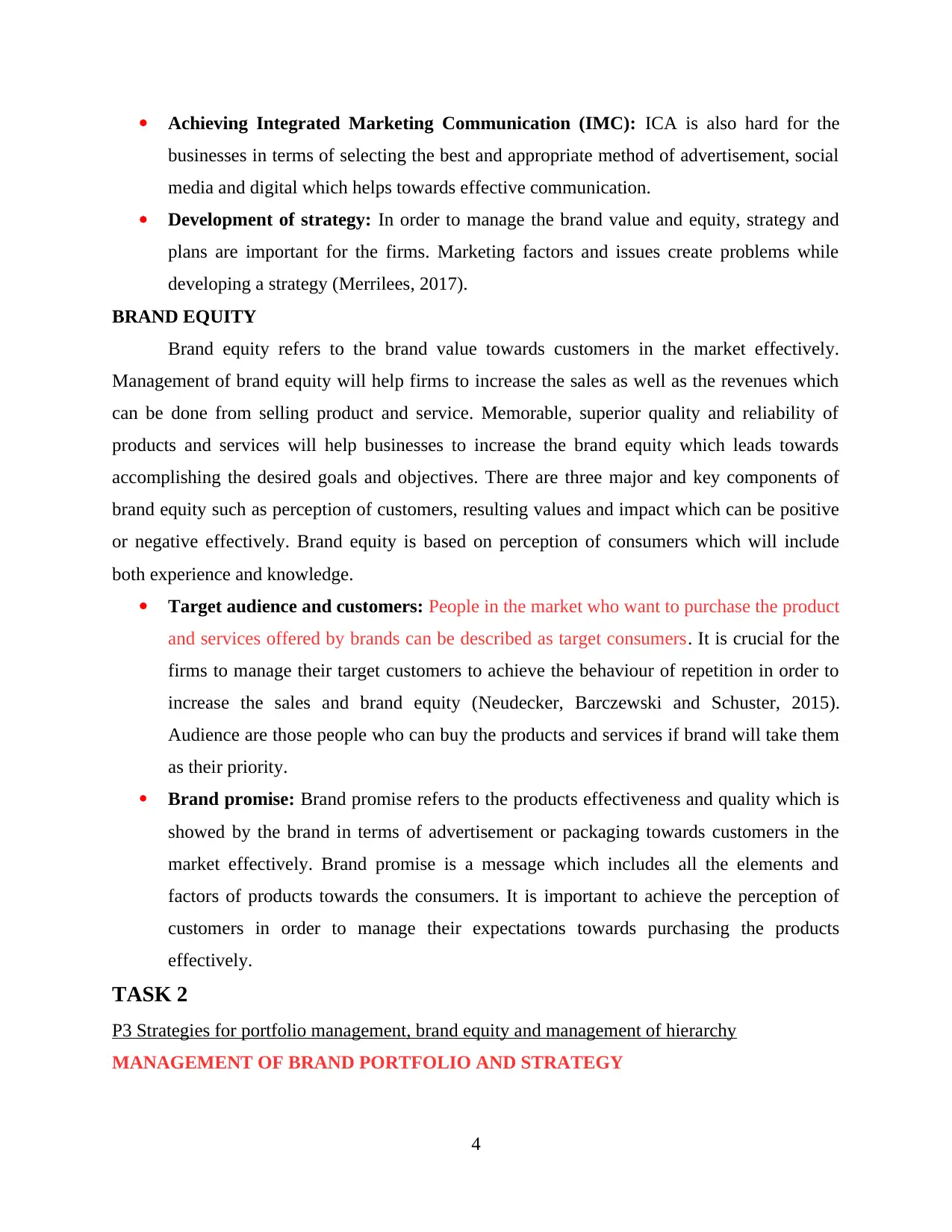
Achieving Integrated Marketing Communication (IMC): ICA is also hard for the
businesses in terms of selecting the best and appropriate method of advertisement, social
media and digital which helps towards effective communication.
Development of strategy: In order to manage the brand value and equity, strategy and
plans are important for the firms. Marketing factors and issues create problems while
developing a strategy (Merrilees, 2017).
BRAND EQUITY
Brand equity refers to the brand value towards customers in the market effectively.
Management of brand equity will help firms to increase the sales as well as the revenues which
can be done from selling product and service. Memorable, superior quality and reliability of
products and services will help businesses to increase the brand equity which leads towards
accomplishing the desired goals and objectives. There are three major and key components of
brand equity such as perception of customers, resulting values and impact which can be positive
or negative effectively. Brand equity is based on perception of consumers which will include
both experience and knowledge.
Target audience and customers: People in the market who want to purchase the product
and services offered by brands can be described as target consumers. It is crucial for the
firms to manage their target customers to achieve the behaviour of repetition in order to
increase the sales and brand equity (Neudecker, Barczewski and Schuster, 2015).
Audience are those people who can buy the products and services if brand will take them
as their priority.
Brand promise: Brand promise refers to the products effectiveness and quality which is
showed by the brand in terms of advertisement or packaging towards customers in the
market effectively. Brand promise is a message which includes all the elements and
factors of products towards the consumers. It is important to achieve the perception of
customers in order to manage their expectations towards purchasing the products
effectively.
TASK 2
P3 Strategies for portfolio management, brand equity and management of hierarchy
MANAGEMENT OF BRAND PORTFOLIO AND STRATEGY
4
businesses in terms of selecting the best and appropriate method of advertisement, social
media and digital which helps towards effective communication.
Development of strategy: In order to manage the brand value and equity, strategy and
plans are important for the firms. Marketing factors and issues create problems while
developing a strategy (Merrilees, 2017).
BRAND EQUITY
Brand equity refers to the brand value towards customers in the market effectively.
Management of brand equity will help firms to increase the sales as well as the revenues which
can be done from selling product and service. Memorable, superior quality and reliability of
products and services will help businesses to increase the brand equity which leads towards
accomplishing the desired goals and objectives. There are three major and key components of
brand equity such as perception of customers, resulting values and impact which can be positive
or negative effectively. Brand equity is based on perception of consumers which will include
both experience and knowledge.
Target audience and customers: People in the market who want to purchase the product
and services offered by brands can be described as target consumers. It is crucial for the
firms to manage their target customers to achieve the behaviour of repetition in order to
increase the sales and brand equity (Neudecker, Barczewski and Schuster, 2015).
Audience are those people who can buy the products and services if brand will take them
as their priority.
Brand promise: Brand promise refers to the products effectiveness and quality which is
showed by the brand in terms of advertisement or packaging towards customers in the
market effectively. Brand promise is a message which includes all the elements and
factors of products towards the consumers. It is important to achieve the perception of
customers in order to manage their expectations towards purchasing the products
effectively.
TASK 2
P3 Strategies for portfolio management, brand equity and management of hierarchy
MANAGEMENT OF BRAND PORTFOLIO AND STRATEGY
4
⊘ This is a preview!⊘
Do you want full access?
Subscribe today to unlock all pages.

Trusted by 1+ million students worldwide
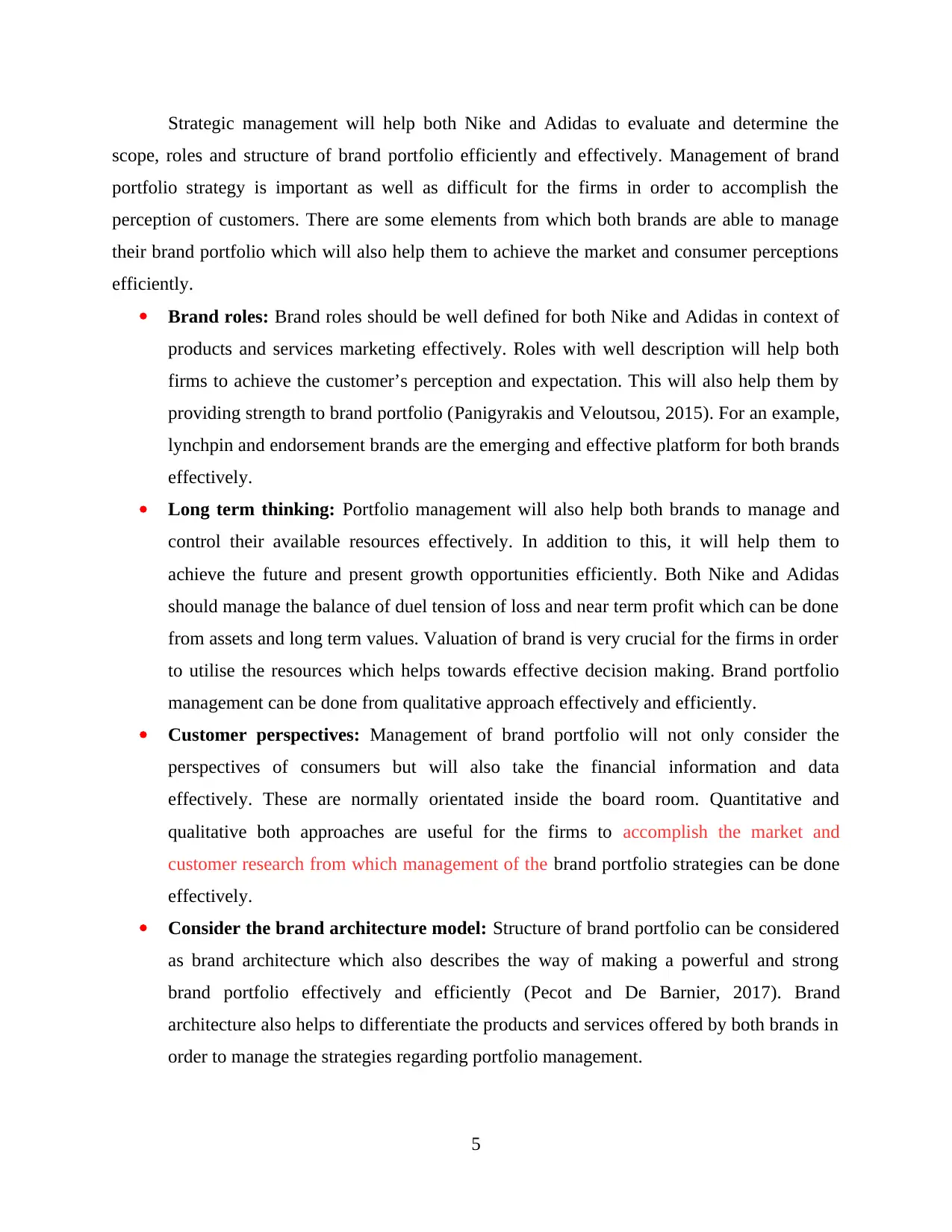
Strategic management will help both Nike and Adidas to evaluate and determine the
scope, roles and structure of brand portfolio efficiently and effectively. Management of brand
portfolio strategy is important as well as difficult for the firms in order to accomplish the
perception of customers. There are some elements from which both brands are able to manage
their brand portfolio which will also help them to achieve the market and consumer perceptions
efficiently.
Brand roles: Brand roles should be well defined for both Nike and Adidas in context of
products and services marketing effectively. Roles with well description will help both
firms to achieve the customer’s perception and expectation. This will also help them by
providing strength to brand portfolio (Panigyrakis and Veloutsou, 2015). For an example,
lynchpin and endorsement brands are the emerging and effective platform for both brands
effectively.
Long term thinking: Portfolio management will also help both brands to manage and
control their available resources effectively. In addition to this, it will help them to
achieve the future and present growth opportunities efficiently. Both Nike and Adidas
should manage the balance of duel tension of loss and near term profit which can be done
from assets and long term values. Valuation of brand is very crucial for the firms in order
to utilise the resources which helps towards effective decision making. Brand portfolio
management can be done from qualitative approach effectively and efficiently.
Customer perspectives: Management of brand portfolio will not only consider the
perspectives of consumers but will also take the financial information and data
effectively. These are normally orientated inside the board room. Quantitative and
qualitative both approaches are useful for the firms to accomplish the market and
customer research from which management of the brand portfolio strategies can be done
effectively.
Consider the brand architecture model: Structure of brand portfolio can be considered
as brand architecture which also describes the way of making a powerful and strong
brand portfolio effectively and efficiently (Pecot and De Barnier, 2017). Brand
architecture also helps to differentiate the products and services offered by both brands in
order to manage the strategies regarding portfolio management.
5
scope, roles and structure of brand portfolio efficiently and effectively. Management of brand
portfolio strategy is important as well as difficult for the firms in order to accomplish the
perception of customers. There are some elements from which both brands are able to manage
their brand portfolio which will also help them to achieve the market and consumer perceptions
efficiently.
Brand roles: Brand roles should be well defined for both Nike and Adidas in context of
products and services marketing effectively. Roles with well description will help both
firms to achieve the customer’s perception and expectation. This will also help them by
providing strength to brand portfolio (Panigyrakis and Veloutsou, 2015). For an example,
lynchpin and endorsement brands are the emerging and effective platform for both brands
effectively.
Long term thinking: Portfolio management will also help both brands to manage and
control their available resources effectively. In addition to this, it will help them to
achieve the future and present growth opportunities efficiently. Both Nike and Adidas
should manage the balance of duel tension of loss and near term profit which can be done
from assets and long term values. Valuation of brand is very crucial for the firms in order
to utilise the resources which helps towards effective decision making. Brand portfolio
management can be done from qualitative approach effectively and efficiently.
Customer perspectives: Management of brand portfolio will not only consider the
perspectives of consumers but will also take the financial information and data
effectively. These are normally orientated inside the board room. Quantitative and
qualitative both approaches are useful for the firms to accomplish the market and
customer research from which management of the brand portfolio strategies can be done
effectively.
Consider the brand architecture model: Structure of brand portfolio can be considered
as brand architecture which also describes the way of making a powerful and strong
brand portfolio effectively and efficiently (Pecot and De Barnier, 2017). Brand
architecture also helps to differentiate the products and services offered by both brands in
order to manage the strategies regarding portfolio management.
5
Paraphrase This Document
Need a fresh take? Get an instant paraphrase of this document with our AI Paraphraser
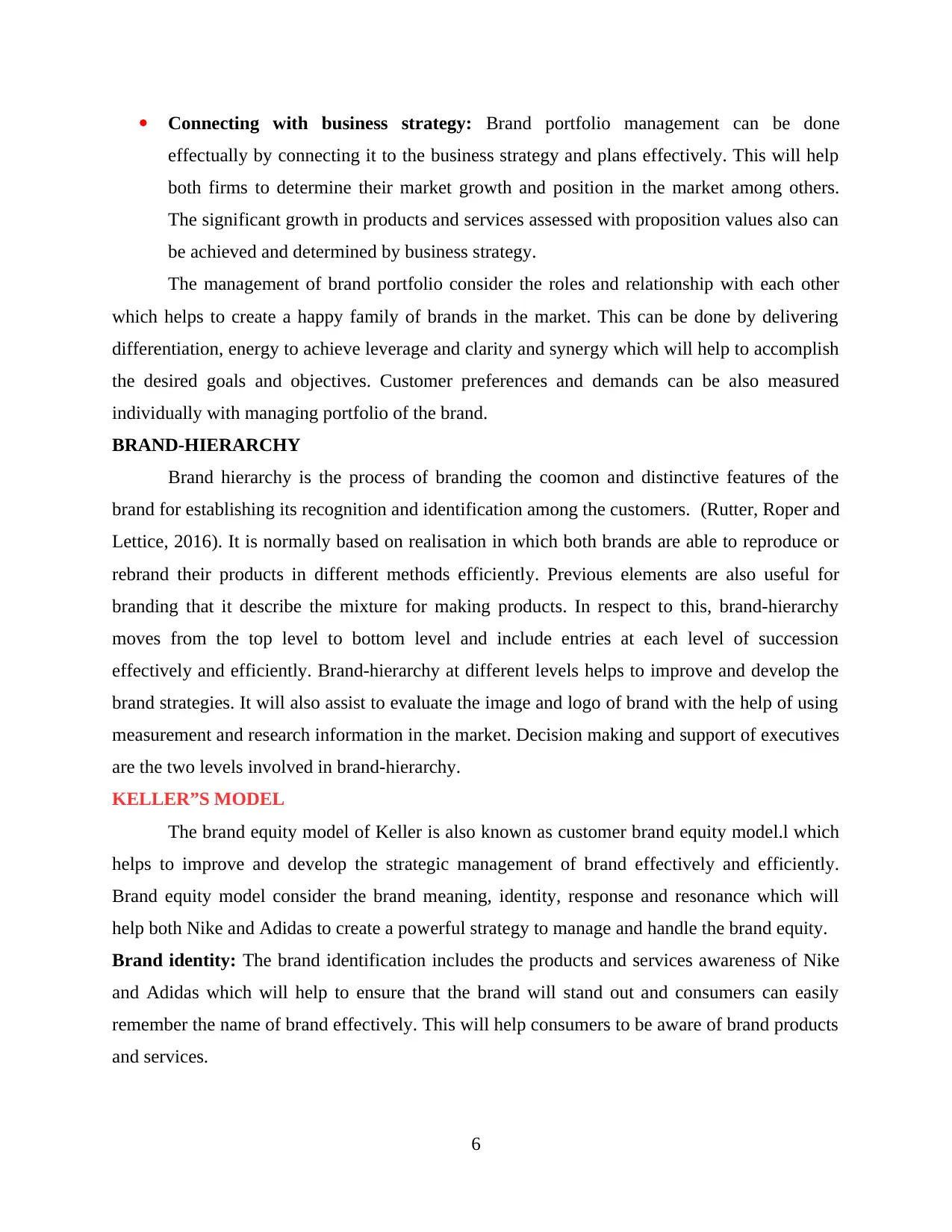
Connecting with business strategy: Brand portfolio management can be done
effectually by connecting it to the business strategy and plans effectively. This will help
both firms to determine their market growth and position in the market among others.
The significant growth in products and services assessed with proposition values also can
be achieved and determined by business strategy.
The management of brand portfolio consider the roles and relationship with each other
which helps to create a happy family of brands in the market. This can be done by delivering
differentiation, energy to achieve leverage and clarity and synergy which will help to accomplish
the desired goals and objectives. Customer preferences and demands can be also measured
individually with managing portfolio of the brand.
BRAND-HIERARCHY
Brand hierarchy is the process of branding the coomon and distinctive features of the
brand for establishing its recognition and identification among the customers. (Rutter, Roper and
Lettice, 2016). It is normally based on realisation in which both brands are able to reproduce or
rebrand their products in different methods efficiently. Previous elements are also useful for
branding that it describe the mixture for making products. In respect to this, brand-hierarchy
moves from the top level to bottom level and include entries at each level of succession
effectively and efficiently. Brand-hierarchy at different levels helps to improve and develop the
brand strategies. It will also assist to evaluate the image and logo of brand with the help of using
measurement and research information in the market. Decision making and support of executives
are the two levels involved in brand-hierarchy.
KELLER”S MODEL
The brand equity model of Keller is also known as customer brand equity model.l which
helps to improve and develop the strategic management of brand effectively and efficiently.
Brand equity model consider the brand meaning, identity, response and resonance which will
help both Nike and Adidas to create a powerful strategy to manage and handle the brand equity.
Brand identity: The brand identification includes the products and services awareness of Nike
and Adidas which will help to ensure that the brand will stand out and consumers can easily
remember the name of brand effectively. This will help consumers to be aware of brand products
and services.
6
effectually by connecting it to the business strategy and plans effectively. This will help
both firms to determine their market growth and position in the market among others.
The significant growth in products and services assessed with proposition values also can
be achieved and determined by business strategy.
The management of brand portfolio consider the roles and relationship with each other
which helps to create a happy family of brands in the market. This can be done by delivering
differentiation, energy to achieve leverage and clarity and synergy which will help to accomplish
the desired goals and objectives. Customer preferences and demands can be also measured
individually with managing portfolio of the brand.
BRAND-HIERARCHY
Brand hierarchy is the process of branding the coomon and distinctive features of the
brand for establishing its recognition and identification among the customers. (Rutter, Roper and
Lettice, 2016). It is normally based on realisation in which both brands are able to reproduce or
rebrand their products in different methods efficiently. Previous elements are also useful for
branding that it describe the mixture for making products. In respect to this, brand-hierarchy
moves from the top level to bottom level and include entries at each level of succession
effectively and efficiently. Brand-hierarchy at different levels helps to improve and develop the
brand strategies. It will also assist to evaluate the image and logo of brand with the help of using
measurement and research information in the market. Decision making and support of executives
are the two levels involved in brand-hierarchy.
KELLER”S MODEL
The brand equity model of Keller is also known as customer brand equity model.l which
helps to improve and develop the strategic management of brand effectively and efficiently.
Brand equity model consider the brand meaning, identity, response and resonance which will
help both Nike and Adidas to create a powerful strategy to manage and handle the brand equity.
Brand identity: The brand identification includes the products and services awareness of Nike
and Adidas which will help to ensure that the brand will stand out and consumers can easily
remember the name of brand effectively. This will help consumers to be aware of brand products
and services.
6
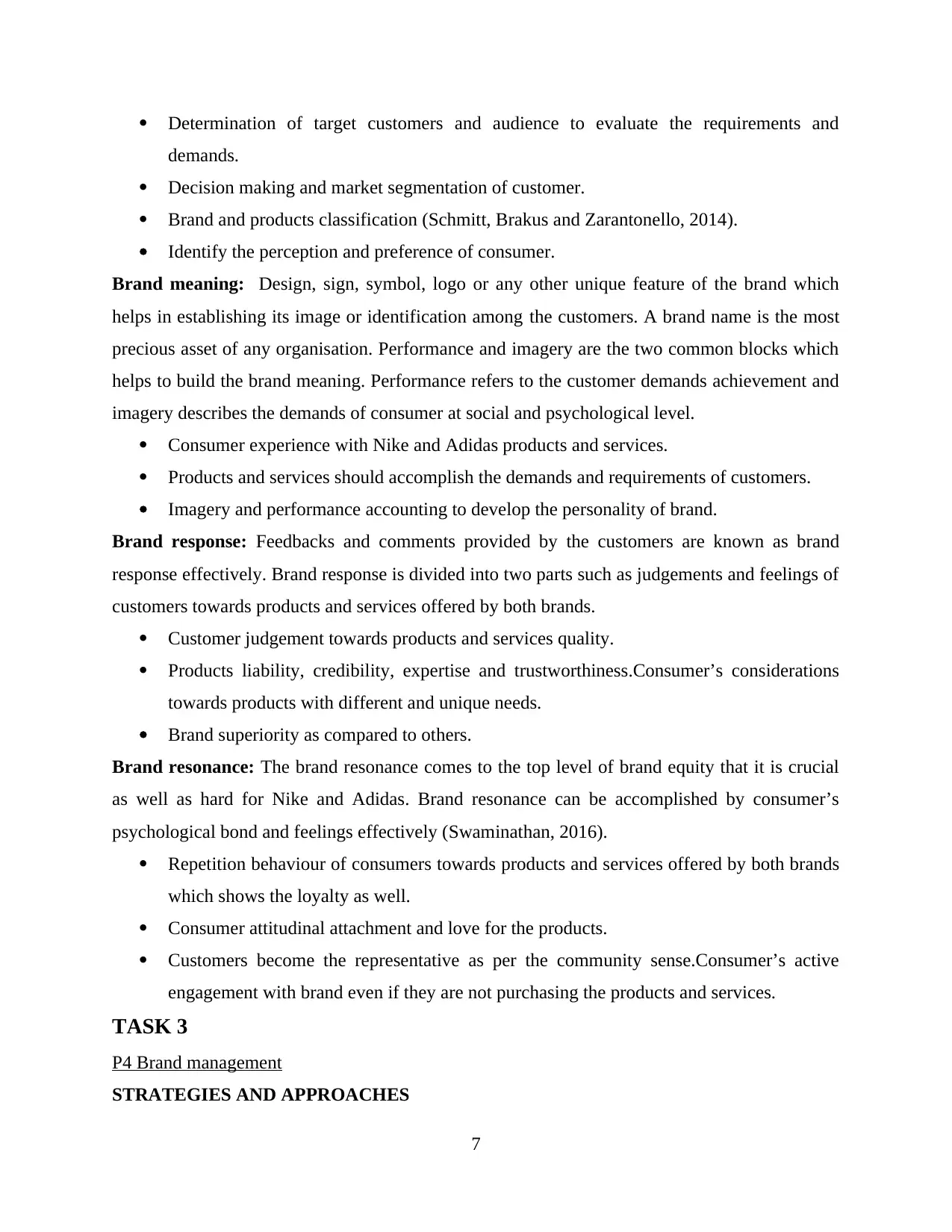
Determination of target customers and audience to evaluate the requirements and
demands.
Decision making and market segmentation of customer.
Brand and products classification (Schmitt, Brakus and Zarantonello, 2014).
Identify the perception and preference of consumer.
Brand meaning: Design, sign, symbol, logo or any other unique feature of the brand which
helps in establishing its image or identification among the customers. A brand name is the most
precious asset of any organisation. Performance and imagery are the two common blocks which
helps to build the brand meaning. Performance refers to the customer demands achievement and
imagery describes the demands of consumer at social and psychological level.
Consumer experience with Nike and Adidas products and services.
Products and services should accomplish the demands and requirements of customers.
Imagery and performance accounting to develop the personality of brand.
Brand response: Feedbacks and comments provided by the customers are known as brand
response effectively. Brand response is divided into two parts such as judgements and feelings of
customers towards products and services offered by both brands.
Customer judgement towards products and services quality.
Products liability, credibility, expertise and trustworthiness.Consumer’s considerations
towards products with different and unique needs.
Brand superiority as compared to others.
Brand resonance: The brand resonance comes to the top level of brand equity that it is crucial
as well as hard for Nike and Adidas. Brand resonance can be accomplished by consumer’s
psychological bond and feelings effectively (Swaminathan, 2016).
Repetition behaviour of consumers towards products and services offered by both brands
which shows the loyalty as well.
Consumer attitudinal attachment and love for the products.
Customers become the representative as per the community sense.Consumer’s active
engagement with brand even if they are not purchasing the products and services.
TASK 3
P4 Brand management
STRATEGIES AND APPROACHES
7
demands.
Decision making and market segmentation of customer.
Brand and products classification (Schmitt, Brakus and Zarantonello, 2014).
Identify the perception and preference of consumer.
Brand meaning: Design, sign, symbol, logo or any other unique feature of the brand which
helps in establishing its image or identification among the customers. A brand name is the most
precious asset of any organisation. Performance and imagery are the two common blocks which
helps to build the brand meaning. Performance refers to the customer demands achievement and
imagery describes the demands of consumer at social and psychological level.
Consumer experience with Nike and Adidas products and services.
Products and services should accomplish the demands and requirements of customers.
Imagery and performance accounting to develop the personality of brand.
Brand response: Feedbacks and comments provided by the customers are known as brand
response effectively. Brand response is divided into two parts such as judgements and feelings of
customers towards products and services offered by both brands.
Customer judgement towards products and services quality.
Products liability, credibility, expertise and trustworthiness.Consumer’s considerations
towards products with different and unique needs.
Brand superiority as compared to others.
Brand resonance: The brand resonance comes to the top level of brand equity that it is crucial
as well as hard for Nike and Adidas. Brand resonance can be accomplished by consumer’s
psychological bond and feelings effectively (Swaminathan, 2016).
Repetition behaviour of consumers towards products and services offered by both brands
which shows the loyalty as well.
Consumer attitudinal attachment and love for the products.
Customers become the representative as per the community sense.Consumer’s active
engagement with brand even if they are not purchasing the products and services.
TASK 3
P4 Brand management
STRATEGIES AND APPROACHES
7
⊘ This is a preview!⊘
Do you want full access?
Subscribe today to unlock all pages.

Trusted by 1+ million students worldwide
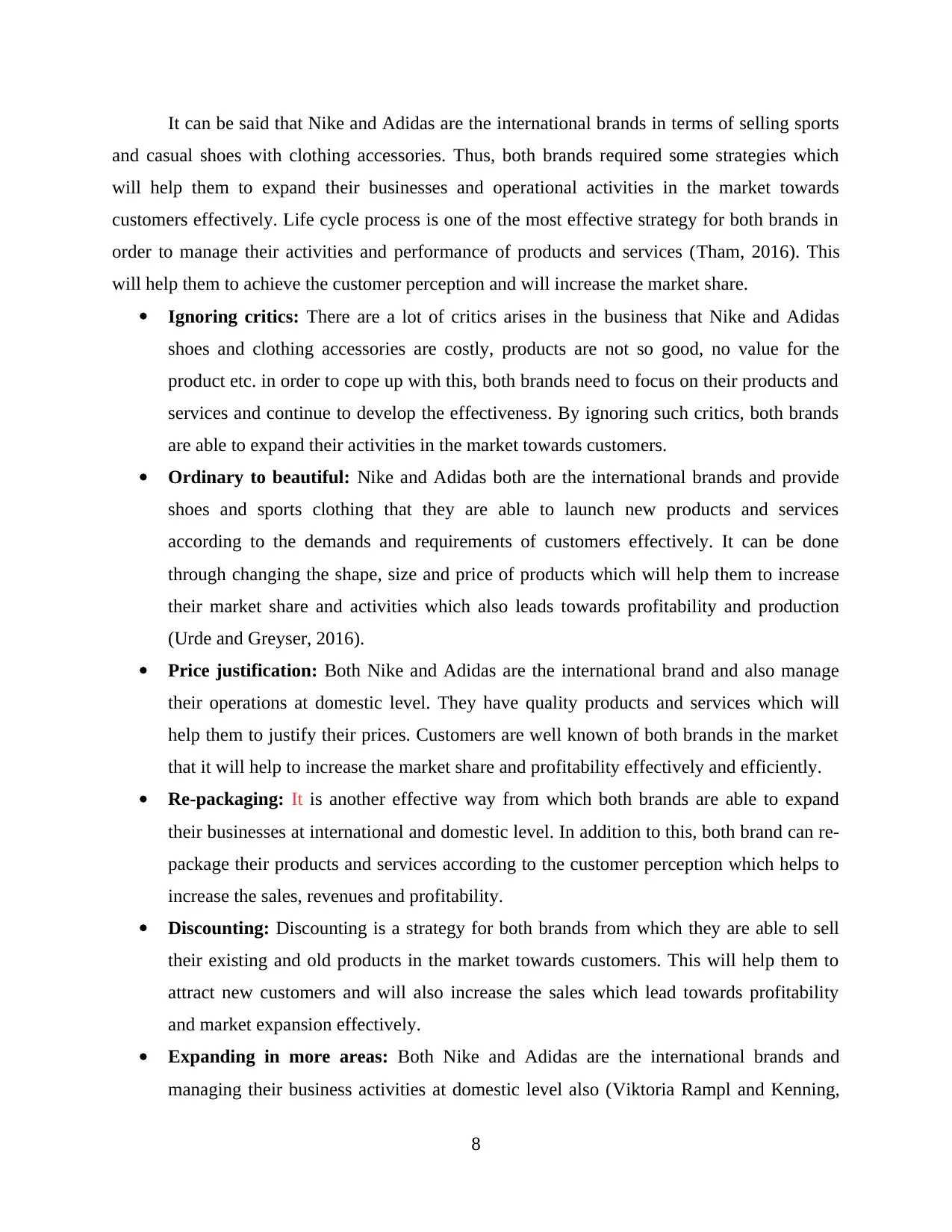
It can be said that Nike and Adidas are the international brands in terms of selling sports
and casual shoes with clothing accessories. Thus, both brands required some strategies which
will help them to expand their businesses and operational activities in the market towards
customers effectively. Life cycle process is one of the most effective strategy for both brands in
order to manage their activities and performance of products and services (Tham, 2016). This
will help them to achieve the customer perception and will increase the market share.
Ignoring critics: There are a lot of critics arises in the business that Nike and Adidas
shoes and clothing accessories are costly, products are not so good, no value for the
product etc. in order to cope up with this, both brands need to focus on their products and
services and continue to develop the effectiveness. By ignoring such critics, both brands
are able to expand their activities in the market towards customers.
Ordinary to beautiful: Nike and Adidas both are the international brands and provide
shoes and sports clothing that they are able to launch new products and services
according to the demands and requirements of customers effectively. It can be done
through changing the shape, size and price of products which will help them to increase
their market share and activities which also leads towards profitability and production
(Urde and Greyser, 2016).
Price justification: Both Nike and Adidas are the international brand and also manage
their operations at domestic level. They have quality products and services which will
help them to justify their prices. Customers are well known of both brands in the market
that it will help to increase the market share and profitability effectively and efficiently.
Re-packaging: It is another effective way from which both brands are able to expand
their businesses at international and domestic level. In addition to this, both brand can re-
package their products and services according to the customer perception which helps to
increase the sales, revenues and profitability.
Discounting: Discounting is a strategy for both brands from which they are able to sell
their existing and old products in the market towards customers. This will help them to
attract new customers and will also increase the sales which lead towards profitability
and market expansion effectively.
Expanding in more areas: Both Nike and Adidas are the international brands and
managing their business activities at domestic level also (Viktoria Rampl and Kenning,
8
and casual shoes with clothing accessories. Thus, both brands required some strategies which
will help them to expand their businesses and operational activities in the market towards
customers effectively. Life cycle process is one of the most effective strategy for both brands in
order to manage their activities and performance of products and services (Tham, 2016). This
will help them to achieve the customer perception and will increase the market share.
Ignoring critics: There are a lot of critics arises in the business that Nike and Adidas
shoes and clothing accessories are costly, products are not so good, no value for the
product etc. in order to cope up with this, both brands need to focus on their products and
services and continue to develop the effectiveness. By ignoring such critics, both brands
are able to expand their activities in the market towards customers.
Ordinary to beautiful: Nike and Adidas both are the international brands and provide
shoes and sports clothing that they are able to launch new products and services
according to the demands and requirements of customers effectively. It can be done
through changing the shape, size and price of products which will help them to increase
their market share and activities which also leads towards profitability and production
(Urde and Greyser, 2016).
Price justification: Both Nike and Adidas are the international brand and also manage
their operations at domestic level. They have quality products and services which will
help them to justify their prices. Customers are well known of both brands in the market
that it will help to increase the market share and profitability effectively and efficiently.
Re-packaging: It is another effective way from which both brands are able to expand
their businesses at international and domestic level. In addition to this, both brand can re-
package their products and services according to the customer perception which helps to
increase the sales, revenues and profitability.
Discounting: Discounting is a strategy for both brands from which they are able to sell
their existing and old products in the market towards customers. This will help them to
attract new customers and will also increase the sales which lead towards profitability
and market expansion effectively.
Expanding in more areas: Both Nike and Adidas are the international brands and
managing their business activities at domestic level also (Viktoria Rampl and Kenning,
8
Paraphrase This Document
Need a fresh take? Get an instant paraphrase of this document with our AI Paraphraser
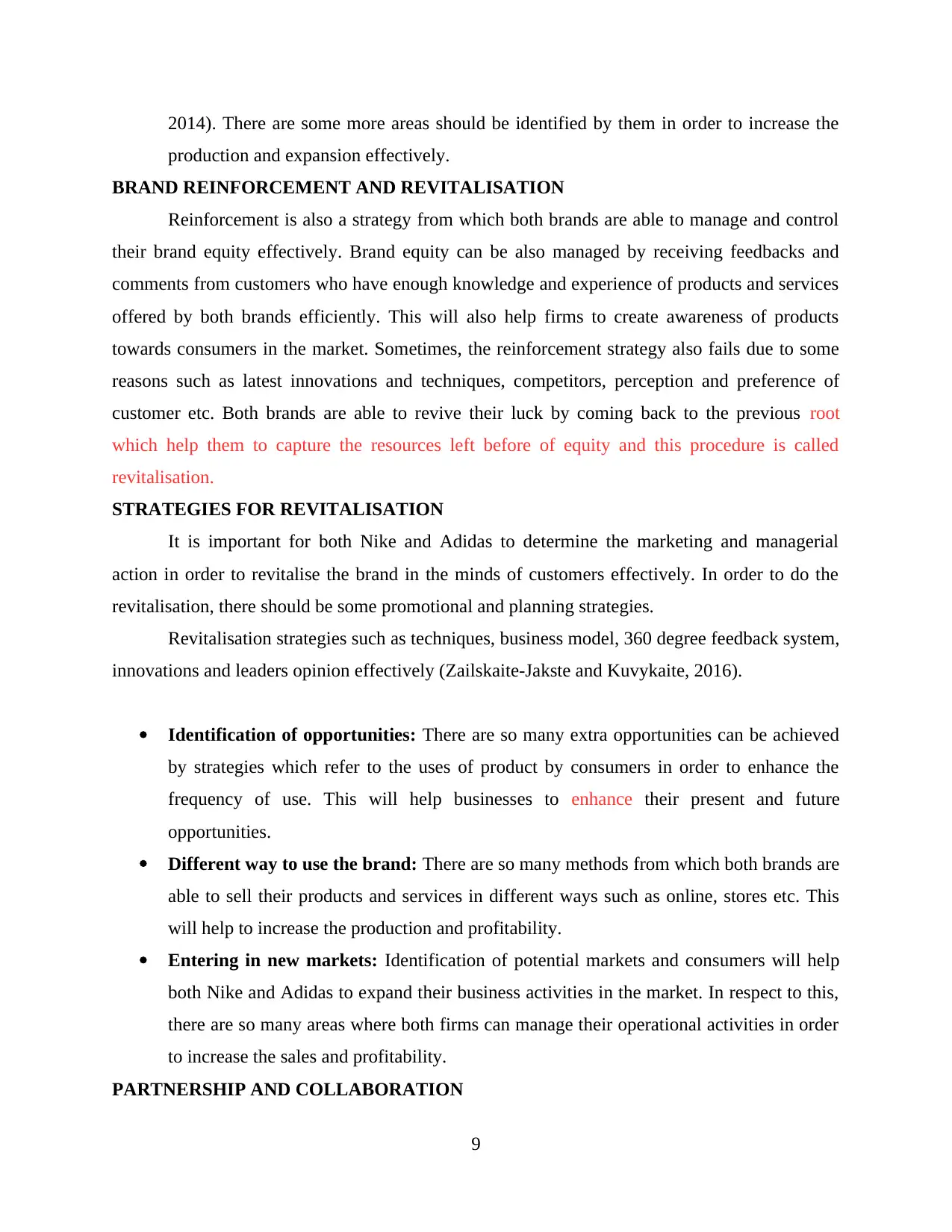
2014). There are some more areas should be identified by them in order to increase the
production and expansion effectively.
BRAND REINFORCEMENT AND REVITALISATION
Reinforcement is also a strategy from which both brands are able to manage and control
their brand equity effectively. Brand equity can be also managed by receiving feedbacks and
comments from customers who have enough knowledge and experience of products and services
offered by both brands efficiently. This will also help firms to create awareness of products
towards consumers in the market. Sometimes, the reinforcement strategy also fails due to some
reasons such as latest innovations and techniques, competitors, perception and preference of
customer etc. Both brands are able to revive their luck by coming back to the previous root
which help them to capture the resources left before of equity and this procedure is called
revitalisation.
STRATEGIES FOR REVITALISATION
It is important for both Nike and Adidas to determine the marketing and managerial
action in order to revitalise the brand in the minds of customers effectively. In order to do the
revitalisation, there should be some promotional and planning strategies.
Revitalisation strategies such as techniques, business model, 360 degree feedback system,
innovations and leaders opinion effectively (Zailskaite-Jakste and Kuvykaite, 2016).
Identification of opportunities: There are so many extra opportunities can be achieved
by strategies which refer to the uses of product by consumers in order to enhance the
frequency of use. This will help businesses to enhance their present and future
opportunities.
Different way to use the brand: There are so many methods from which both brands are
able to sell their products and services in different ways such as online, stores etc. This
will help to increase the production and profitability.
Entering in new markets: Identification of potential markets and consumers will help
both Nike and Adidas to expand their business activities in the market. In respect to this,
there are so many areas where both firms can manage their operational activities in order
to increase the sales and profitability.
PARTNERSHIP AND COLLABORATION
9
production and expansion effectively.
BRAND REINFORCEMENT AND REVITALISATION
Reinforcement is also a strategy from which both brands are able to manage and control
their brand equity effectively. Brand equity can be also managed by receiving feedbacks and
comments from customers who have enough knowledge and experience of products and services
offered by both brands efficiently. This will also help firms to create awareness of products
towards consumers in the market. Sometimes, the reinforcement strategy also fails due to some
reasons such as latest innovations and techniques, competitors, perception and preference of
customer etc. Both brands are able to revive their luck by coming back to the previous root
which help them to capture the resources left before of equity and this procedure is called
revitalisation.
STRATEGIES FOR REVITALISATION
It is important for both Nike and Adidas to determine the marketing and managerial
action in order to revitalise the brand in the minds of customers effectively. In order to do the
revitalisation, there should be some promotional and planning strategies.
Revitalisation strategies such as techniques, business model, 360 degree feedback system,
innovations and leaders opinion effectively (Zailskaite-Jakste and Kuvykaite, 2016).
Identification of opportunities: There are so many extra opportunities can be achieved
by strategies which refer to the uses of product by consumers in order to enhance the
frequency of use. This will help businesses to enhance their present and future
opportunities.
Different way to use the brand: There are so many methods from which both brands are
able to sell their products and services in different ways such as online, stores etc. This
will help to increase the production and profitability.
Entering in new markets: Identification of potential markets and consumers will help
both Nike and Adidas to expand their business activities in the market. In respect to this,
there are so many areas where both firms can manage their operational activities in order
to increase the sales and profitability.
PARTNERSHIP AND COLLABORATION
9
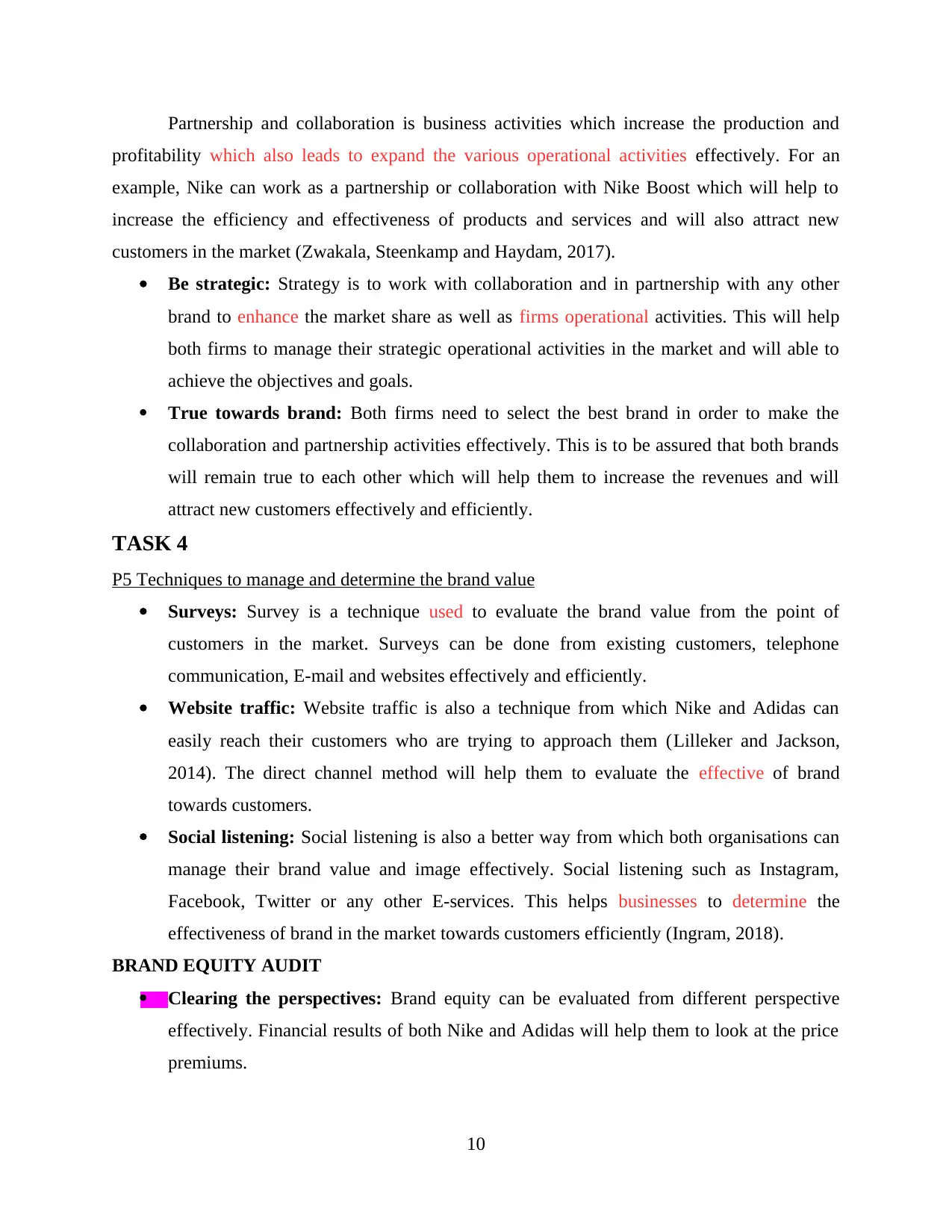
Partnership and collaboration is business activities which increase the production and
profitability which also leads to expand the various operational activities effectively. For an
example, Nike can work as a partnership or collaboration with Nike Boost which will help to
increase the efficiency and effectiveness of products and services and will also attract new
customers in the market (Zwakala, Steenkamp and Haydam, 2017).
Be strategic: Strategy is to work with collaboration and in partnership with any other
brand to enhance the market share as well as firms operational activities. This will help
both firms to manage their strategic operational activities in the market and will able to
achieve the objectives and goals.
True towards brand: Both firms need to select the best brand in order to make the
collaboration and partnership activities effectively. This is to be assured that both brands
will remain true to each other which will help them to increase the revenues and will
attract new customers effectively and efficiently.
TASK 4
P5 Techniques to manage and determine the brand value
Surveys: Survey is a technique used to evaluate the brand value from the point of
customers in the market. Surveys can be done from existing customers, telephone
communication, E-mail and websites effectively and efficiently.
Website traffic: Website traffic is also a technique from which Nike and Adidas can
easily reach their customers who are trying to approach them (Lilleker and Jackson,
2014). The direct channel method will help them to evaluate the effective of brand
towards customers.
Social listening: Social listening is also a better way from which both organisations can
manage their brand value and image effectively. Social listening such as Instagram,
Facebook, Twitter or any other E-services. This helps businesses to determine the
effectiveness of brand in the market towards customers efficiently (Ingram, 2018).
BRAND EQUITY AUDIT
Clearing the perspectives: Brand equity can be evaluated from different perspective
effectively. Financial results of both Nike and Adidas will help them to look at the price
premiums.
10
profitability which also leads to expand the various operational activities effectively. For an
example, Nike can work as a partnership or collaboration with Nike Boost which will help to
increase the efficiency and effectiveness of products and services and will also attract new
customers in the market (Zwakala, Steenkamp and Haydam, 2017).
Be strategic: Strategy is to work with collaboration and in partnership with any other
brand to enhance the market share as well as firms operational activities. This will help
both firms to manage their strategic operational activities in the market and will able to
achieve the objectives and goals.
True towards brand: Both firms need to select the best brand in order to make the
collaboration and partnership activities effectively. This is to be assured that both brands
will remain true to each other which will help them to increase the revenues and will
attract new customers effectively and efficiently.
TASK 4
P5 Techniques to manage and determine the brand value
Surveys: Survey is a technique used to evaluate the brand value from the point of
customers in the market. Surveys can be done from existing customers, telephone
communication, E-mail and websites effectively and efficiently.
Website traffic: Website traffic is also a technique from which Nike and Adidas can
easily reach their customers who are trying to approach them (Lilleker and Jackson,
2014). The direct channel method will help them to evaluate the effective of brand
towards customers.
Social listening: Social listening is also a better way from which both organisations can
manage their brand value and image effectively. Social listening such as Instagram,
Facebook, Twitter or any other E-services. This helps businesses to determine the
effectiveness of brand in the market towards customers efficiently (Ingram, 2018).
BRAND EQUITY AUDIT
Clearing the perspectives: Brand equity can be evaluated from different perspective
effectively. Financial results of both Nike and Adidas will help them to look at the price
premiums.
10
⊘ This is a preview!⊘
Do you want full access?
Subscribe today to unlock all pages.

Trusted by 1+ million students worldwide
1 out of 16
Related Documents
Your All-in-One AI-Powered Toolkit for Academic Success.
+13062052269
info@desklib.com
Available 24*7 on WhatsApp / Email
![[object Object]](/_next/static/media/star-bottom.7253800d.svg)
Unlock your academic potential
Copyright © 2020–2025 A2Z Services. All Rights Reserved. Developed and managed by ZUCOL.





